Have you ever noticed that extra little leg of gas piping running to your furnace or water heater and wondered what the heck happened? They’re sediment traps.
Sediment traps are intentionally installed to help prevent sediment in the gas piping from getting into the gas valve or burner area of an appliance and fouling things up. The photo below shows eighteen years of sediment accumulation at the first sediment trap at my own house, which is located on the main gas line just before the pressure regulator.
I’ve taken apart many sediment traps out of curiosity, and this was the first one where I’ve actually found anything. The sediment traps at my furnace and water heater were completely empty. Sediment traps have been required for approximately forever, and they’re still required today by the Minnesota State Fuel Gas Code.
Side note: old-school guys and girls call them “drip tees”, “drip legs”, “dirt legs”, and several other names that you won’t find in the current code.
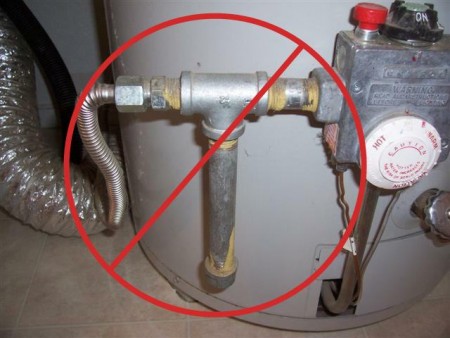 The basic requirements for sediment traps:
The basic requirements for sediment traps:
- Must be installed as close to the inlet of the equipment as practical
- Must be installed ahead of all pounds-to-inches pressure regulators
- Must be made of a tee fitting with a capped nipple, a minimum of 3 inches in length, in the bottom opening of the run of the tee
- Provide a 90-degree change of direction of gas flow, to help prevent sediment from flowing over the trap. The photo at right is an improper installation, because it does not provide this.
- The cap shall be at an elevation lower than the tee fitting.
While the old code language only required sediment traps where the gas piping dropped down to appliances, there is no longer such language in the code. Sediment traps are required at all automatically controlled gas appliances. The code defines an automatically controlled appliance as “Appliances equipped with an automatic burner ignition and safety shutoff device and other automatic devices which accomplish complete turn-on and shutoff of the gas to the main burner or burners, and graduate the gas supply to the burner or burners, but do not affect complete shutoff of the gas.”
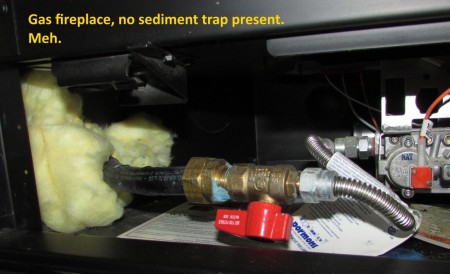 In other words, sediments traps are required at furnaces, boilers, water heaters, clothes dryers, ovens, space heaters, unit heaters, gas fireplaces, and more. Despite these requirements, I personally can’t recall ever seeing one installed at a gas fireplace, they’re almost never installed at ovens, and just yesterday I inspected a new construction home with a clothes dryer in the basement that was missing a sediment trap on the gas line. It seems that installers and municipal inspectors don’t care much about the presence or absence of sediment trap. Quite frankly, I don’t either.
In other words, sediments traps are required at furnaces, boilers, water heaters, clothes dryers, ovens, space heaters, unit heaters, gas fireplaces, and more. Despite these requirements, I personally can’t recall ever seeing one installed at a gas fireplace, they’re almost never installed at ovens, and just yesterday I inspected a new construction home with a clothes dryer in the basement that was missing a sediment trap on the gas line. It seems that installers and municipal inspectors don’t care much about the presence or absence of sediment trap. Quite frankly, I don’t either.
Side note: the 2012 IRC, which is NOT what is used for the fuel gas code in MN, says in section G2419.4: “illuminating appliances, ranges, clothes dryers, decorative vented appliances for installation in vented fireplaces, gas fireplaces, and outdoor grills need not be so equipped.” So there’s that.
If you look at your appliance and you don’t have a sediment trap, don’t sweat it. It’s not a big deal. Just plan to have it corrected the next time the appliance is replaced. Or not. If it doesn’t get corrected, it’s probably not a big deal. If you hear someone make a big deal about this, tell them to worry about something more important, like dinner.
To see the full text giving the requirements for sediment traps in Minnesota, click here https://codes.iccsafe.org/public/document/MMFGC2015/chapter-4-gas-piping-installations and scroll down to section 408.4, or check out the image below.

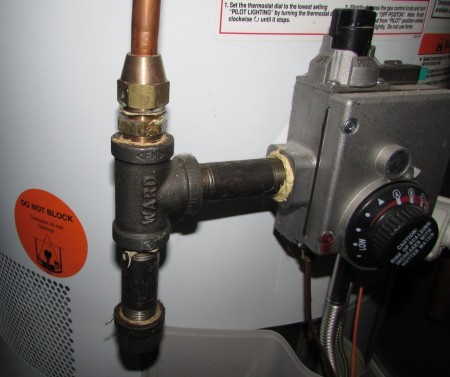
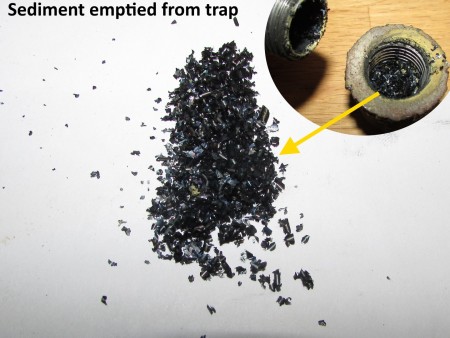
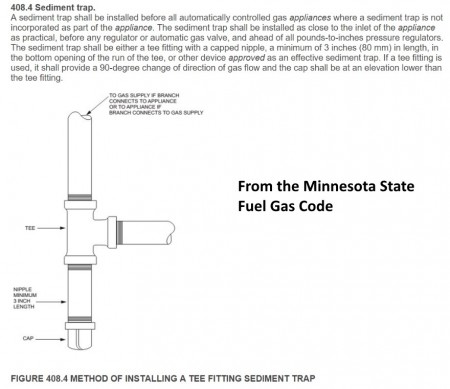
Chris
May 29, 2016, 6:50 am
Hi Reuben,
Thanks very much for the pic of an improper sediment trap.
Chris, NJ
brent
June 6, 2016, 6:22 am
Good info. Thinking of extending an unused gas line outside to feed an outdoor grill. I’ll be sure to include the trap!